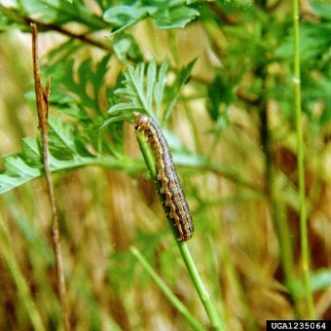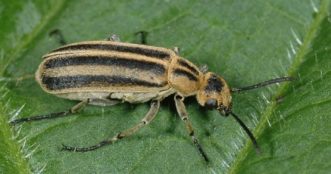Alfalfa is a perennial legume with high forage quality that can be used under grazing or hay management. This publication outlines establishment and management recommendations for alfalfa plantings in South Carolina.
Introduction
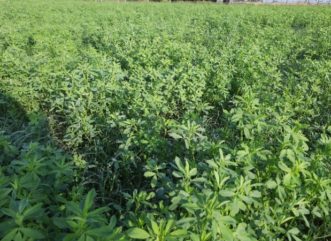
Figure 1. Alfalfa ‘Bulldog 805’ stand. Image credit: Liliane Silva, Clemson University Cooperative Extension.
Alfalfa (Medicago sativa L.) is a perennial legume with high forage production and quality.1 Alfalfa once represented a large acreage in the southern United States, but challenges related to weather conditions and insect and disease pressure decreased its presence in the region over time.2 The development of improved varieties and management strategies are resulting in the incorporation of alfalfa back into forage systems in the Southeast.3 Understanding proper strategies for alfalfa establishment and management is crucial to optimizing the longevity and feasibility of alfalfa-based forage systems for producers in South Carolina (figure 1).
Alfalfa Varieties
Alfalfa is a perennial legume with purple flowers, compound leaves with three leaflets, and a taproot root system. Alfalfa has high fertility requirements, is adapted to well-drained soils for adequate growth, and has limited tolerance to diseases and pests. Several alfalfa varieties are available and are classified based on the fall dormancy scale (table 1). The fall dormancy scale rates alfalfa varieties based on their response to temperature and day length, reflecting their ability to continue to grow during the fall and winter months. Generally, varieties with dormancy ratings from 4 to 8 can succeed in South Carolina, depending on location. It is essential to properly select an alfalfa variety well adapted to your site and the planned management strategy (hay production, grazing management, or dual-purpose). Consult your local Extension Agent for help choosing the best variety adapted to your location and weather conditions.
Table 1. Fall dormancy rating of alfalfa varieties. Adapted from Hancock et al. (2015)4 and NAFA (2022).5
| Dormancy | Rating | Notes |
|---|---|---|
| Very dormant | 1,2 | Very winter hardy. No fall or winter growth. |
| Dormant | 3,4 | Winter hardy. Little growth during fall and later winter. |
| Moderate dormant | 5 | Moderate winter hardy. Moderate growth during fall and late winter. |
| Semi-dormant | 6,7 | Not winter hardy. Fall and late winter growth. |
| Nondormant | 8,9 | Good fall and late winter growth. |
| Very non-dormant | 10,11 | Growth continues through the fall and winter months. |
In the Southeast, two of the most used alfalfa varieties are Alfagraze and Bulldog, which were developed by Dr. Joe Bouton, Emeritus Professor of the University of Georgia. Alfagraze was released back in 1990, and it was the first southern variety adapted to grazing management. The incorporation of the Roundup Ready® (RR) technology has allowed for better weed control on Alfagraze stands, and there are two commercialized varieties available—Alfagraze 300 RR and Alfagraze 600 RR. The Alfagraze 600 RR variety has a dormancy rating of 6 and has high disease resistance to Fusarium wilt and root-knot nematode. All varieties that contain the RR technology require farm registration and a technology fee payment through the seed vendor. The Bulldog variety is a dual-purpose variety which means that it can be used under hay or grazing management and does not incorporate RR technology. Bulldog 505 is rated 5 for dormancy and has good disease resistance and drought tolerance. Similarly, Bulldog 805 (figure 1) has good disease and drought resistance, but it has a dormancy rating of 8, which may limit its use to southern portions of the state.
Another variety adapted to the Southeast is HarvXtra®. This variety contains the RR technology and was genetically modified with reduced lignin concentration in the plant. This modification gives more flexibility to the cutting window for growers when the harvest is not possible during the optimal (re)growth period. There are ongoing breeding efforts from commercial and land-grant universities in the Southeast to develop new alfalfa varieties adapted to the region. For additional information on varieties available, consult the National Alfalfa and Forage Alliance (NAFA) website, alfalfa.org.
Stand Establishment
Before establishment, soil testing should be conducted to determine amendments needed for optimal soil pH and nutrient levels. Alfalfa plants have a deep taproot system that explores the subsoil layer, which requires pH correction at a greater depth than more commonly grown forages. For alfalfa, it is recommended to sample to a 15-inch depth by dividing the soil profile into two layers, the surface (0-8 inches) and sub-surface depth (8-15 inches). Soil pH should range from 6.5 to 7.0 on the soil surface and over 6.0 at sub-surface depths. Based on the soil report results, apply recommended lime, phosphorus (P), and potassium (K) fertilizers. Plan to apply lime six to eight months before the alfalfa stand will be planted to allow for soil incorporation. It may be necessary to conduct multiple lime applications to correct pH. If sub-surface soil results in aluminum toxicity, applying gypsum (CaSO4) can be beneficial. Gypsum does not correct the soil pH, but it penetrates the soil profile and helps reduce the amount of soluble aluminum. As previously mentioned, a sub-surface soil sample must be tested to determine the amendments needed. Adequate levels of boron (B) and molybdenum (Mo) are essential for nodule formation and biological nitrogen (N) fixation on alfalfa plants. Some varieties may already have these nutrients included in the seed coat.
Consult your local Extension agent well in advance of the planting date to assist with selecting an alfalfa variety adapted to your farm location and allow adequate time for land preparation, soil amendments, and securing seeds. Thus, purchase high-quality alfalfa seeds and store them properly before planting. Most seeds are pre-inoculated with an inoculant (Rhizobium spp.). If seeds are improperly stored or handled, the inoculant can be inactivated. A well-prepared, weed-free seedbed is essential when establishing an alfalfa stand, and weed control ahead of time will be crucial to avoid competition from weeds during early alfalfa development.
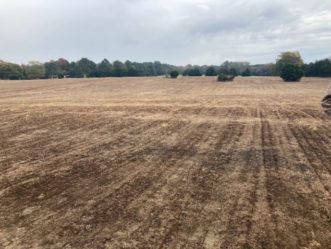
Figure 2. Land prepared for planting. Image credit: Liliane Silva, Clemson University Cooperative Extension.
Before planting, the area should be well prepared to ensure a firm seedbed for establishment (figure 2). For example, the boot imprints should be no deeper than ¼ inch after walking across a well-prepared area. Always calibrate planting equipment. Seeds can be sown using a no-till drill with a small seedbox or broadcasted. If broadcasted, a cultipacker should follow to ensure adequate seed contact with the soil. Based on the planting method used, the seeding rate is between 20 lb to 25 lb pure live seed (PLS)/acre, and seeds should be placed no more than ¼ inch deep. Generally, the recommendation would be to plant in South Carolina from late August to late October. It is ideal to allow the alfalfa seedlings to grow for six to eight weeks before the first hard frost. A hard frost when plants are young can injure or kill them if they are not developed enough to withstand the lower temperatures.
Weed Control
Before establishment, control weeds to limit competition for resources and optimize the establishment of alfalfa. The use of non-selective herbicides associated with proper seedbed preparation and adequate planting date are effective practices to improve stand establishment. When selecting a site, it is crucial to know the history of herbicide use. The area should not have been treated with soil residual herbicides, such as GrazonNext® or DuraCor®, in the past twelve to eighteen months. For example, products containing the active ingredients picloram (e.g., Surmount®, Graslan®), aminopyralid (e.g., Milestone®, Chapparal™), and triclopyr (e.g., Remedy® Ultra, Garlon 411®) can leave residues in the soil long after the initial product application that can result in stunting, chlorosis, or death of newly planted alfalfa. If the site was treated with these products within eighteen months, conduct a field bioassay where short rows of alfalfa are planted across the original direction of the application, such that variations in soil texture, organic matter, pH, and drainage are represented in the test.
For site preparation, start early and determine the weed species in the area. Knowing the species present helps to identify the best strategies for control. Herbicide options are more limited when using a Roundup Ready® (conventional) alfalfa variety. Most postemergence products can only be used when alfalfa has reached at least the third trifoliate leaf or is about 4 to 6 inches tall. Always read and follow the label instructions and be aware of specific harvest restrictions associated with the use of certain herbicides for hay production or grazing management.
Fertility Management
After establishment, it is important to conduct soil testing routinely to monitor soil pH and nutrient levels. Soil pH should be maintained in a range of 6.5 to 7.0. Alfalfa has high nutrient requirements, and the most common nutrient deficiencies are visually identifiable in the field. For example, deficiency symptoms for K include stunted plant growth, poor root system development, and yellow to white spots forming in the margins of the leaves that evolve to senescence. More information about the nutrient deficiency symptoms can be found in the alfalfa-bermudagrass management guide.3 Potassium (K) fertilization should be well addressed because it is one of the primary nutrients required by alfalfa. Generally, the recommended rate ranges between 250 to 400 lb K/acre for the growing season. The total K rate application should be split applied to improve its use efficiency by plants. Based on how intensively the alfalfa stand is managed, K total rate should be split into three to four applications, if possible.
When managing an alfalfa-bermudagrass mixture, it is crucial to adjust the K rate because both forage species have high K requirements. Because alfalfa is a legume, there is no need to apply N fertilizer; however, it will be necessary to supplement Mo and B yearly based on soil and plant tissue analyses. Scouting alfalfa fields weekly throughout the growing season is recommended to visually assess nutrient deficiency symptoms as they appear. Plant tissue testing should be conducted mid-growing season to assess plant nutrient status, permitting supplemental nutrient applications as needed.
Forage Management and Production
For alfalfa monocultures, hay production is the most common harvest management used. In the year of establishment, the first cut should occur when the alfalfa stand has reached or surpassed 25% blooming which will allow the alfalfa plants to have adequately established their roots systems and accumulated energy reserves. Then, subsequent harvests should occur every twenty-eight to thirty-five days or at 10% bloom during the growing season.6 The recommended stubble height is four inches to allow plants to have enough residual leaf area remaining for regrowth and replenishment of energy reserves during the regrowth period. The number of cuttings per season will vary based on weather conditions, and the last cutting of the season should occur prior to the first hard frost event. The targeted moisture level should range from 15% to 18% for hay production, which can be challenging during the rainy season. Some producers may opt to use hay preservatives to improve the chances of maintaining forage quality throughout this process.
For forage systems managed under grazing, a variety tolerant to grazing should be used, and rotational management implemented. Alfalfa does not tolerate continuous grazing management because the lack of rest periods compromises the plant’s ability to persist.6 The recommendations for regrowth period and stubble height are similar to those recommended for hay production. When animals are first exposed to alfalfa pastures, especially in early spring, do not turn animals in an alfalfa pasture when hungry and ensure they have free access to a grass pasture or hay. The hay will help to dilute the proportion of legumes in the diet. Only turn animals into an alfalfa stand for incremental periods of time (hours per day). Providing a bloat-reducing supplement, such as poloxalene or an ionophore, can help reduce the incidence of bloat. Some producers may use alfalfa stands under creep grazing or under a first-last grazing strategy to supply the higher nutritional needs of animals in the herd. For the first-last grazer strategy, the animals with higher nutritional needs graze a given pasture first, then the second group of animals with lower nutrient requirements are given access to it.
Annual forage production in alfalfa ranges from four to ten tons per acre, depending on the fertilization and harvest management applied. Forage production distribution usually spans April through September/October for South Carolina, depending on weather conditions and location. For the Southeast, stand longevity is expected to be between three and five years under adequate fertility and harvest management. In terms of forage quality, generally, crude protein and total digestible nutrients range from 18% to 25% and 60% to 65%, respectively. A 3-year study at Piedmont in Clemson, South Carolina, evaluated three alfalfa varieties (TQR®, HarvXtra®, and Alfagraze) managed under three harvest intensities (28-, 35- or 42-day regrowth period). The average forage production ranged from 5,240 to 8,423 lb/acre among harvest intensities (unpublished data).
Insect Control
Most insects found in alfalfa stands are either beneficial or incidental and are not associated with forage yield losses throughout the growing season. Scout your alfalfa fields from February through the last cutting of the growing season to identify and monitor insect pest occurrence. In the southeast United States, important insect pests include grasshoppers (Orthoptera: Acrididae), leafhoppers, such as potato leafhopper, Empoasca fabae (Harris), the alfalfa weevil (Hypera postica [Gyllenhal]), armyworms (Lepidoptera: Noctuidae), the threecornered alfalfa hopper (Spissistilus festinus [Say]), aphids (Hemiptera: Aphididae), and blister beetles (Coleoptera: Meloidae).7 Generally, weevils and grasshoppers occur in mid-February through March, while beetles, leafhoppers, and caterpillars may occur in early summer forward.
The best strategy is to scout fields weekly during the growing season and use integrated pest management strategies as needed to control insect pests. When scouting alfalfa, one can use the pan or bucket method at multiple sites throughout a field. Multiple plants are collected and beaten inside or over a bucket or pan, and the insects that fall from the plants are counted to determine insect pressure. The sweep-net method is another alternative and requires walking through the field, sweeping the net through the forage canopy at least ten times in multiple locations, counting the number of insects per sweep, and checking to see if it meets the threshold required for treatment.
Several species of caterpillars (figure 3) can infest alfalfa, and population numbers may vary due to several environmental factors. Caterpillars can cause significant damage and may require several insecticide applications for control. The general recommendation is to apply insecticide when two to three caterpillars are present per square foot in a field.7 Depending on the size of the insect and residual activity of the product, it may be necessary to spray fields seven to fourteen days after the first application. Use the sweep-net method regularly to monitor their density.
Although not as common in the Southeast, several species of blister beetles (figure 4) can occur in alfalfa stands, including the striped blister beetle, Epicauta vittata (Fabricius), the margined blister beetle, E. funebris Horn or E. pestifera Werner, the ashgray blister beetle, E. fabricii (LeConte), the black blister beetle, and E. pennsylvanica (De Geer).1 When blister beetles occur in alfalfa stands, the primary concern is related to the production of cantharidin which is a toxic chemical compound that can be poisonous if consumed.8 Beetles can swarm and, if present in the hay, can be crushed and consumed by livestock, causing sickness or death in the animals. There are several species of blister beetles, and the production of cantharidin may vary among species. An animal’s response to consuming hay containing cantharidin will depend on the amount of the poisonous compound and the animal’s age, size, breed, and overall health. Horses are more sensitive to cantharidin than other classes of livestock. For help on insect pest identification and control options, more information is provided in the Land-Grant Press publication “Insect Pests of Alfalfa in the Southeastern United States” (lgpress.clemson.edu/publication/insect-pests-of-alfalfa-in-the-southeastern-united-states/).
Mixture with Grasses
Alfalfa can also be planted as a mixture with grasses, such as tall fescue (Festuca arundinacea) and bermudagrass (Cynodon dactylon). Over the past years, alfalfa has been increasingly incorporated into bermudagrass systems throughout the Southeast due to their similar soil fertility and drainage requirements and complementary growth patterns, allowing for extended forage availability into fall months in the region (figure 5). Thus, alfalfa improves forage quality and inputs organic N into the systems, which is supplied to the companion grass. In this context, there is a decrease in the use of chemical nitrogen (N) fertilizer in the forage systems, resulting in economic and environmental benefits. When considering establishing alfalfa into a bermudagrass stand, it is essential to consider previous field history, especially any herbicides used over the past eighteen months. If a soil residual herbicide was used to control broadleaf weeds, determine the active ingredient, application rate, and the required planting interval for sowing alfalfa. If the site was treated with these products within eighteen months, conduct a field bioassay where short rows of alfalfa are planted across the original direction of the application, such that variations in soil texture, organic matter, pH, and drainage are represented in the test.
Prior to sowing alfalfa, mow closely or heavily graze the bermudagrass stand to remove excessive forage mass and optimize seed-soil contact. After removing plant residue, spray a suppression rate of glyphosate (9 oz/acre if 5.5 lb. a.i. formulation or at 12 oz/acre if 4 lb. a.i. formulation) to induce bermudagrass dormancy. The recommended seeding rate is 12 to 15 lbs PLS/acre using a 14- to 15-inch row spacing. For more information about the establishment, production, and management of alfalfa-bermudagrass mixtures, please consult the management guide3 or your local Extension Agent. Contact information for county offices is available on the Clemson Cooperative Extension website (clemson.edu/extension/co/index.html).
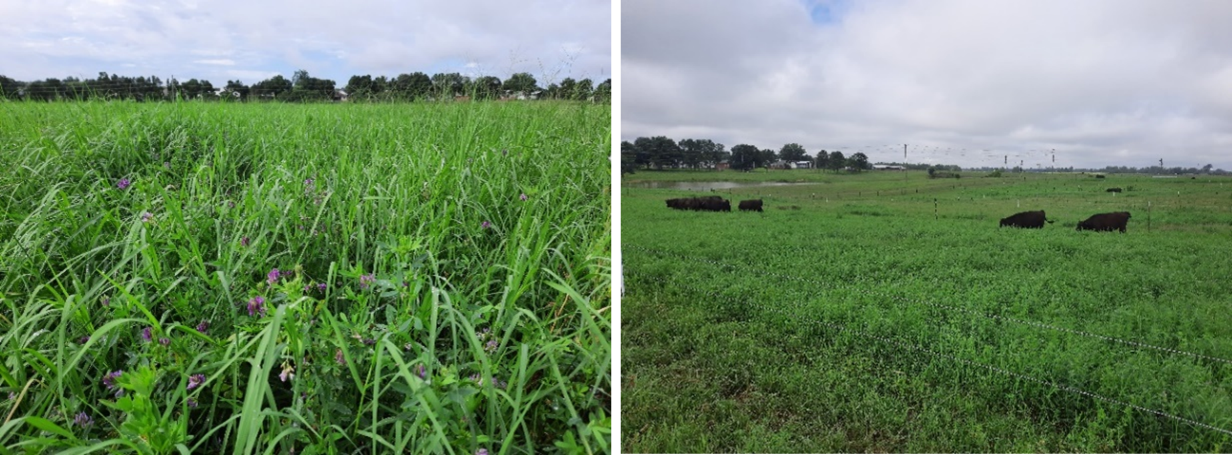
Figure 5. Alfalfa-bermudagrass mixture stand managed under grazing. Image credit: Liliane Silva, Clemson University.
References Cited
- Ball DM, Hoveland CS, Lacefield G.D. 2015. Southern Forages: Modern concepts for forage crop management, 5th edition. International Plant Nutrition Institute. Peachtree Corners, GA.
- Lacefield G, Ball D, Hancock D, Andrae J, Smith R. 2009. Growing alfalfa in the South. Available at https://www.alfalfa.org/pdf/alfalfainthesouth.pdf.
- Silva LS, Mullenix MK, Tucker JJ, Prevatt CG. 2021. Perceptions on adoption of alfalfa plantings by forage-livestock producers in the Southeast US. Applied Animal Sciences, 37:6, 665-669.
- Hancock D, Buntin GD, Ely LO, Lacy RC, Heusner GL, Stewart Jr RL. Alfalfa management in Georgia. Athens (GA): University of Georgia, UGA Extension; 2015. Bulletin 1350. https://secure.caes.uga.edu/extension/publications/files/pdf/B%201350_3.PDF.
- NAFA. Alfalfa variety ratings 2022: winter survival fall dormancy and pest resistance ratings for alfalfa varieties. St. Paul (MN): National Alfalfa and Forage Alliance (NAFA); 2022. https://www.alfalfa.org/varietyLeaflet.php.
- Tucker J, Mullenix K, Silva L, Prevatt C, Samac D, Kesheimer K, Tomaso-Peterson M. 2022. Alfalfa-bermudagrass management guide and calendar. St. Paul (MN): National Alfalfa and Forage Alliance (NAFA). https://www.alfalfa.org/pdf/AlfalfaBermudagrass-LowRes.pdf.
- Greene J, Bryant TB, Reay-Jones FP, Silva LS. Insect pests of alfalfa in the southeastern United States. Clemson (SC): Clemson Cooperative Extension, Land-Grant Press by Clemson Extension; 2022 Jul. LGP 1149. https://lgpress.clemson.edu/publication/insect-pests-of-alfalfa-in-the-southeastern-united-states/.
- Blodgett SL, Carrel JE, Higgins RA. 1992. Cantharidin contamination of alfalfa hay. Journal of Medical Entomology. 1992 Jul;29(4):700–703. doi:10.1093/jmedent/29.4.700.
Additional Resources
Ball DM, Hoveland CS, Lacefield GD. Southern Forages: modern concepts for forage crop management, 5th ed. Peachtree Corners (GA): International Plant Nutrition Institute; 2015.
Lacefield G, Ball D, Hancock D, Andrae J, Smith R. Growing alfalfa in the South. 2009. https://www.alfalfa.org/pdf/alfalfainthesouth.pdf.
Lehmkuhler J, VanValin K, Smith R, Henning J, Tucker J, Teutsch C, Lea K. Alfalfa for beef cows. St. Paul (MN): National Alfalfa and Forage Alliance (NAFA); 1991– (revised 2021). https://www.alfalfa.org/pdf/AlfalfaForBeefCows.pdf.
Silva L, Mullenix K, Dillard L, Kesheimer K, Russell D. Alfalfa establishment and management. https://www.aces.edu/blog/topics/farming/alfalfa-establishment-and-management/.

